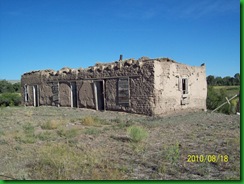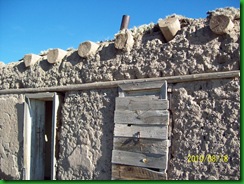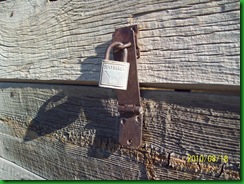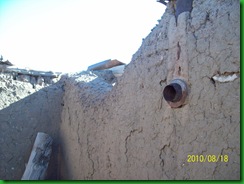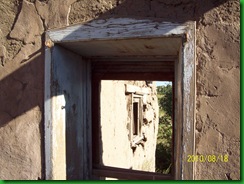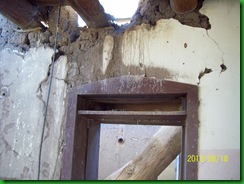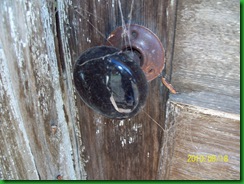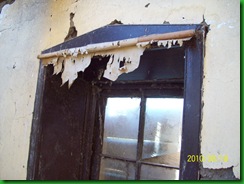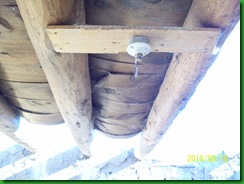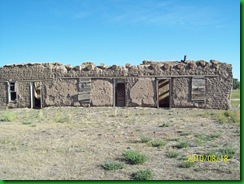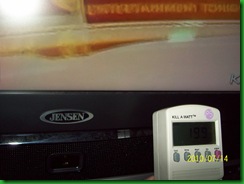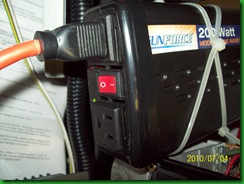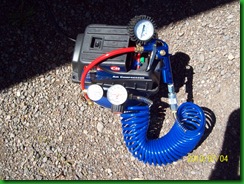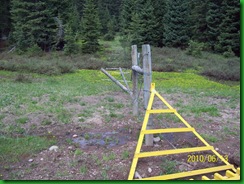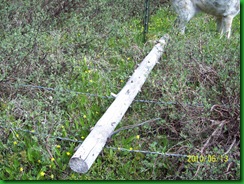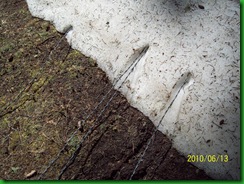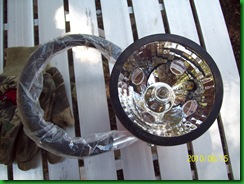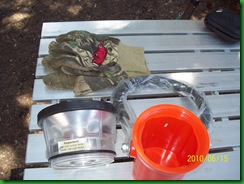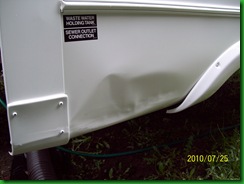Mogote, Colorado, on the banks of the Conejos River.
Thursday, August 19, 2010
Sunday, August 15, 2010
INVERTERS
Some RV’ers elect to install one very large inverter to provide all of their household voltage needs. Some run microwaves, coffee makers, hair dryers and so on and so forth.
Inverters come in all sizes and with lots of features including a wireless remote control. They can be quite expensive. Smaller inverters can be quite the opposite and are readily available locally.
We thought about our camping style and our voltage needs at various times of the day. Our findings kind of surprised us. We realized that we were using our generator un necessarily and that for the most part, a couple of smaller inverters would serve us well. Our goal became to significantly reduce our generator use and improve the quality of our camping experience.
Our first inverter to install was a salvaged out 400 watt unit, from a battery jumper pack. Here it is to the right of the solar controller:
Using this inverter as a test platform, we checked the actual current draws of our various appliances with our Kill A Watt meter.
This photo shows the current draw through the inverter that supplies the office slide out where the 32’ TV , Satellite receiver, two FRS radios and the laptop are being used.
We really enjoy being able to run all that stuff while quietly chatting about the wildlife we see out of the picture window, because the generator isn’t running to disturb them.
Our next inverter to install was a 200 watt unit that normally supplies all of the power that is needed in the office. Here is a look at it:
These two inverters are mounted side by side in the trailer basement. On those occasions when the load requirements in the office are higher than normal, it is easy to switch the office circuit from the 200 watt to the 400 watt inverter.
The 400 watt inverter is mostly used for running appliances such as the pancake air compressor when checking tire pressure or fixing a flat.
Tuesday, August 10, 2010
SOLAR
Here is a look at the roof of SPF60, our nick name for our Coleman model 325 fifth wheel. Even though the thing is nearly 36’ long, it’s beginning to look a bit crowded up there.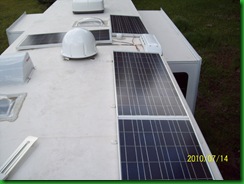
The four Solar panels consist of, a couple of kits that are sold by Camping world that have a charge controller in each kit. Each panel is rated at about 125 watts output for a total of about 500 watts of solar power on the roof.
This solar controller, blue and gray, on the left, monitors the amperage going from the roof mounted panels, down into the battery’s. The controller is located down in the basement and is readily accessible should it need to be consulted. This photo was taken about 10am. The amps to the battery’s is usually in the neighborhood of 22 to 25 amps when the sun is directly overhead.
Why isn’t the controller located up inside the trailer in a prominent location where it can be readily monitored ? The short of that, is that we don’t want another system to have to operate, it just needs to get what energy is available from the sun and store it in the battery’s. We don’t want to worry over a few more watts of efficiency. We think it should be a plug it in and forget it system. If it quits working ( the TV won’t come on ), then we’ll look into it.
My initial plan was to divide the solar system into two separate stand alone systems of 250 watts each. Later I decided that would un necessarily complicate what I wanted to be a simple and dependable, plug and play system.
So, how is it doing for us ? Really good. Our camping style lets us run the TV and satellite system to check news and weather three times a day and watch our favorite shows in the evenings for a total of about five hours on a 32” tv , each day.
The sun is providing all of the power we need, except for about an hour in the mornings when we run the generator to be able to use the coffee maker and microwave.
With the hour of generator use in the morning, our trailer’s converter has a built in smart charger that can really “sock it to” the battery’s if needed, to start the day’s solar power collecting off faster.
Sunday, August 8, 2010
FENCE
Trujillo Meadows has a livestock drift fence around it to keep the range cattle out of the camp. Here is the way it looks when it is up for the Summer.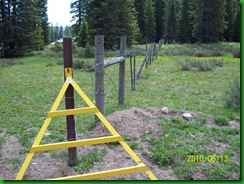
Here is the way it looks when it is down for the Winter.
There are loops to hook over the tee posts when the fence is stood up to keep the range cattle out.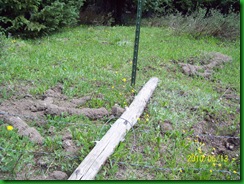
As the snow drifts melt off, we can lift the fence up.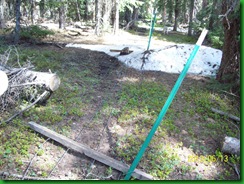
Sometimes the snow has been so deep that the weight of it has compressed the snow into ice and it takes longer for it to melt off.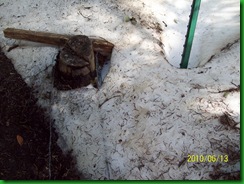
Occasionally trees will fall from the weight of the snow and damage the fence.
Friday, August 6, 2010
TRAINMEN
The ancient Cumbres & Toltec railroad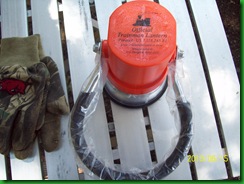
is a strong attraction for railfans and trainmen alike.
Trujillo Meadows Campground is located up the mountain from the Cumbres Station, located in Cumbres Pass.
Campers can hear the steam trains blowing at crossings and other signals at various times of the day.
One of the Trainmen campers gave us a trainmen’s light. What a cool souvenir !
The light has both LED and incandescent bulbs that switch on independently.
Tuesday, August 3, 2010
DENTED
It scared me at first. The bright orange plastic cone came flying out of the on coming line of traffic. Then anger quickly replaced the fear. The interstate highway had narrowed down to two close, tight lanes of traffic in a construction zone. The usual four lanes of traffic traveling 65 MPH, with two lanes going in each direction separated by a wide grass median, had been temporarily rerouted.
We were in closely packed lines of vehicles traveling at 45 MPH, worrying about how tight the lanes were, when we first saw it. We weren’t sure at first what it was. Then we felt the impact and heard the slamming sound. A quick glance in the mirror revealed it to be a bright orange cone that had came flying out of the on coming line of cars, to strike our fifth wheel trailer. Instant anguish !
With less than a thousand miles on our new Coleman 325, we could hardly stand the idea of it being damaged.
At the first opportunity we pulled over to check the damage.
Knowing that it wasn’t our fault didn’t seem to help at all. Who was the idiot that sent the traffic cone flying into the side of our trailer ? There is no way that we will ever know. Weeks have passed since the incident and we are now able to refer to it as the “cone incident”.
On our next two jobs we will be staying in private parks and will likely not have a chance to wash our trailer. So, today we decided to get a quick coat of carnuba wax on it. Washing that damaged area refreshed our memory and renewed pangs of anguish.
The cone hit our trailer just in front of the highway side axles. Right on the dining room slide out. It made a dent in the sheet metal skirt. Everything works well, but we now have a new travel story to tell, and our trailer is beginning to develop some character.
